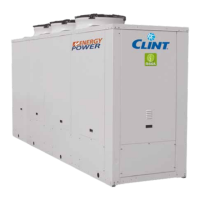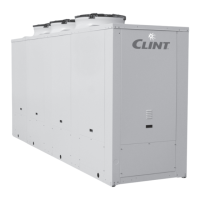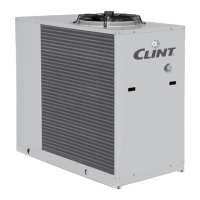31
CHA
9.1.1 Monthly controls
- Make sure the terminals in the electrical panel and
in the compressor terminal board are well tightened.
Check the fixed and mobile contacts of the contactors
and replace them if they are worn.
- Verify the deep closing of the fuses-holder cover.
- Inspect the liquid and moisture indicator to make
sure the right quantity of refrigerant is contained in
the circuit.
- Make sure no oil is leaking from the compressor.
- Make sure that no water is leaking from the water
circuit.
- Drain the water circuit.
- Make sure the flow switch/water differential pressure
switch works correctly.
- Check the heating elements in the compressor
sump.
- Clean the metal filters in the water pipes.
- Clean the finned coil (and the relative metal filters, if
present), by directing a jet of compressed air in the
opposite direction from that of the air flow. If the filters
are very clogged, use a jet of water instead.
- Check that the unit doesn’t make any unusual nois-
es.
- Make sure the possible autifreere kit works correctly
9.1.2 Four-monthly controls
- Make sure the fans are fixed, balanced and in good
condition.
- Check the colour of the liquid and moisture indica-
tor; if the colour indicates a moist circuit, change the
filter.
- Check the state of the paint work: touch up any
scratches in order to prevent rusting.
9.2 REPAIRING THE REFRIGERANT CIRCUIT
These repairs may only be made by spe-
cialised staff using the normal techniques
for chillers that make use of halogen fluids
as refrigerants.
9.3 TOPPING UP THE REFRIGERANT
This operation should only be carried out after identify-
ing and repairing the leak.
For units using R410A no more than two top
ups are allowed. If another top up is required
the refrigerant circuit must be completely
emptied and then filled with new refrigerant.
9.1.1 Controlli mensili
- Verificare il serraggio dei morsetti sia all’interno del
quadro elettrico che nella morsettiera dei compres-
sori. Controllare i contatti mobili e fissi dei teleruttori,
sostituendoli in caso di deterioramento.
- Verificare il serraggio a fondo dei tappi portafusibile.
- Verificare, attraverso l’indicatore di liquido ed umidità,
la corretta carica di refrigerante nel circuito.
- Controllare che il compressore non perda olio.
- Controllare che il circuito idraulico non perda acqua.
- Spurgare l’impianto idraulico.
- Verificare che il flussostato/pressostato differenziale
funzioni in maniera corretta.
- Controllare gli eventuali riscaldatori del carter dei
compressori.
- Pulire i filtri metallici nelle tubazioni idrauliche.
- Pulire la batteria alettata (ed i relativi filtri metallici,
se presenti), utilizzando un getto d’aria compressa
operando in senso inverso rispetto al flusso dell’aria.
Nel caso i filtri siano particolarmente intasati, operare
utilizzando un getto d’acqua.
- Verificare che le emissioni sonore della macchina siano
regolari.
- Controllare il corretto funzionamento delle eventuali
resistenze antigelo presenti.
9.1.2 Controlli quadrimestrali
- Procedere alla verifica dello stato di fissaggio, di
bilanciamento e di condizioni generali delle ventole.
- Verificare il colore dell’indicatore di liquido ed umidità;
se il colore indica circuito umido, va sostituito il filtro.
- Controllare lo stato della verniciatura: eventuali
scalfiture vanno ritoccate per impedire fenomeni di
corrosione.
9.2 RIPARAZIONI DEL CIRCUITO FRIGO
Vanno effettuate solo da personale spe-
cializzato, utilizzando le normali tecniche
tipiche degli impianti di refrigerazione che
impiegano fluidi alogeni quali frigorigeni.
9.3 RABBOCCHI DI REFRIGERANTE
Vanno effettuati solo dopo aver individuato e riparato
i punti di fuga.
Per le unità caricate con R410A è consentito
effettuare non più di due rabbocchi. Qualora
fosse necessario un ulteriore rabbocco si
dovrà svuotare completamente il circuito
frigorifero ed effettuare la ricarica con re-
frigerante vergine.

